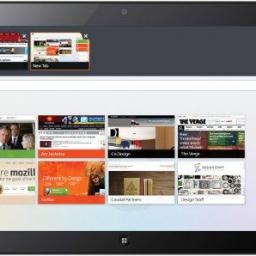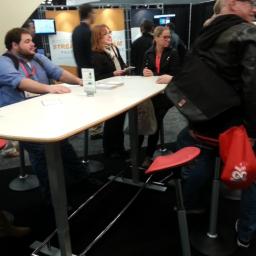The
Cord Cutting movement , in which people choose to do away with cable TV packages in lieu of entertainment provided over the Internet, seems to be picking up the pace. In 2013, the number of American cable TV subscribers dropped for the first time ever, and by the impressive amount of 105,000.
A recent report by the Leichtman Research Group finds that the top nine cable companies lost about 1.8 million video subscribers in 2013 (more than they lost in 2012), while other providers gained some users, for a total (net) loss. 2013 was the first year numbers dropped.
Just a blip on the radar? Or the beginning of something more?
Scientists working with the powerful BICEP (Background Imaging of Cosmic Extragalactic Polarization) telescopes at the South Pole may have
just discovered evidence of the Big Bang Theory that has been sought since the 1970s . Observing the light of 13.8 billion years ago, the team of astronomers, led by John Kovac of the Harvard-Smithsonian Center for Astrophysics, have detected
gravitational waves (ripples in the fabric of space-time).
These gravitational waves have long been theorized but never observed, and provide strong evidence of a theory of cosmology called
Inflation , in which the Big Bang led to an instantaneous inflation of the universe and expansion at speeds that surpass the speed of light. Astrophysicists have been trying to find convincing evidence of the theory for 35 years.
Says the New York Times, "If corroborated, Dr. Kovac's work will stand as a landmark in science comparable to the recent discovery of dark energy pushing the universe apart, or the Big Bang itself." They add:
Confirming inflation would mean that the universe we see, extending 14 billion light-years in space with its hundreds of billions of galaxies, is only an infinitesimal patch in a larger cosmos whose extent, architecture and fate are unknowable. Moreover, beyond our own universe there might be an endless number of other universes bubbling into frothy eternity, like a pot of pasta water boiling over.
We live in amazing times.

Windows 8's unique "metro" interface has required developers to spend a lot of time updating their software to fit into the new environment. And the folks at Mozilla have decided it's not worth their time. They've
dropped support for the project that aimed to bang Firefox into shape for Windows 8, citing lack of demand for the product as the reason. That frees up developers to spend time doing other things, but leaves users with good old Internet Explorer as their primary browser option on the tiled interface.
Mozilla says millions of users have downloaded pre-release builds of the desktop version of Firefox, while fewer than 1000 seem to be actively using the pre-release of Firefox for Windows 8 Metro. If you were holding out for the release version, time to look for other options!

First it was ergonomic keyboards and mice, then ergonomic keyboard trays and lumbar-support chairs. Standing desks came next, and as XKCD points out,
we're not done yet. No surprise then, that the SXSW event led to display of some new ideas,
such as Martin Keen's new Leaning chair, basically a repurposed tractor seat posted at an angle.
How do you stay comfortable for the 23.5 hours that you are parked in front of a computer? And with all this ergonomic stuff,
when will the madness end?Servers need energy and cooling, and outer space has quite a bit of clean solar power and of course low enough temperatures to keep equipment cool for a long time. Does that give you any ideas? It certainly
inspired the folks at server-sky , who are working on the specs for an array of orbiting servers, transferring computation to where it's potentially cheap and using it to serve the needs of the underserved on earth.
Server Sky thinsats are ultralight aluminum foil substrates that convert sunlight into computation and communications. Powered by solar cells, propelled and steered by light pressure, networked and located by microwaves, and cooled by radiation into deep pace. Arrays of tens of thousands of thinsats act as highly redundant computation and database servers, as well as phased array antennas to reach thousands of transceivers on the ground.
First generation Version 5 thinsats are 20 centimeters across (about 8 inches) and 0.04 millimeters (40 microns) thick, and weigh 3 grams. They can be mass produced with off-the-shelf semiconductor and display technologies. Thousands of radio chips provide intra-array, inter-array, and ground communication, as well as precise location information. Thinsats are launched stacked by the thousands in solid cylinders, shrouded and vibration isolated inside a traditional satellite bus."
Of course when they gain sentience and turn against us by blocking out the sun,
then we'll be sorry.Well-known Linux vendor and IT shop Wind River knows the "Internet of Things" is just around the corner, and is
positioning its interesting VxWorks Real Time Operating System (RTOS) to be there when it happens. VxWorks is already in use on embedded systems around the world, and it might be coming to a toaster near you soon.
If you have not heard of VxWorks,
Wikipedia has more info about the Intel-owned company that is quietly putting its 'Intel Inside' mark on over 1.5 billion devices, including NASA's Curiosity rover on Mars.
Wind River redesigned VxWorks so it features two kernels, one for large processors and the other, a micro-kernel, for smaller processors, like the kind that would power edge devices with low compute capacity. The micro-kernel is only 20KB, and can run on 32-bit processors (though not 8-bit or 16-bit processors).
How much longer before our refrigerators flash 'insert coin'?
The folks at "Talking Cloud" (who are coming at the subject from an obvious bias) point out that corporations are looking more and more at a corporate desktop environment
where desktops are in the Cloud. With more and more users needing access to traditional Windows applications inside the corporate firewall, the rise of
Desktop-as-a-Service may be the future for your average worker bee.
Google's Advanced Technology and Projects group has announced a series of three developer events for
Project Ara, which hopes to create a modular smartphone. Google hopes to have a working prototype ready within weeks, with a commercial release in the first quarter of 2015.
Motorola first unveiled the Project Ara initiative in October 2013 and Google is keen to push ahead with the project, despite selling off Motorola to Lenovo last month.
This is possible because Google decided to keep the ATAP group under its Android umbrella when it sold Motorola.
The design for Project Ara is based on the concept of Phonebloks, created by Dutch designer Dave Hakkens. It consists of a structural frame called an "endoskeleton" that holds various modules in place. The modules can be anything ranging from a new display, keyboard, an extra battery or something not yet thought of.
Endoskeletons will come in three sizes and cost approximately $50.

